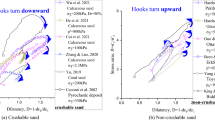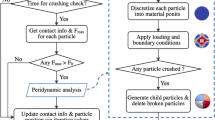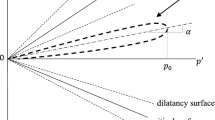Abstract
Due to the high compressibility and low crushing strength induced by remarkable intra-granular void and highly irregular shape, the creep response of calcareous sand is far larger than that of silica sand. Unlike silica sand, the creep behavior of calcareous sand under general stress might be divided into the initial near-linear phase, damping phase, and the steady phase. The three-phase creep behavior is difficult to be well described by general creep models, such as Burgers viscoelastic model. This paper conducted two sets of triaxial creep tests of calcareous sand under general stress state, finding that the three-phase creep is mainly governed by the mechanisms of grain rearrangement, interparticle friction, and particle crushing, respectively. Local instability near cavities on calcareous particles leads to specific initial near-linear phase and damping phase compared to silica sand. Further, a new creep constitutive model was established using different rheological components to theoretically describe the creep characteristics of calcareous sand. The constitutive model was validated and proved to describe creep behavior of calcareous sand reasonably with the test data.








Similar content being viewed by others
References
Bowman ET, Soga K (2003) Creep, ageing and microstructural change in dense granular materials. Soils Found 43(4):107–117
Giang PHH, Impe POV, Impe WFV et al (2017) Small-strain shear modulus of calcareous sand and its dependence on particle characteristics and gradation. Soil Dyn Earthq Eng 100:371–379
Hsieh C, Pan YC (2000) Dynamic behavior and modeling of the pre-sliding static friction. Wear 242:1–17
Karimpour H, Lade PV (2010) Time effects relate to crushing in sand. J Geotech Geoenviron Eng 136(9):1209–1219
Kuwano R, Jardine RJ (2002) On measuring creep behavior in granular materials through triaxial testing. Can Geotech J 39(5):1061–1074
Lade PV (2007) Experimental study and analysis of creep and stress relaxation in granular materials. In Proceedings of New Peaks in Geotechnics, ASCE, p 1–11
Lade PV (2013) Time effects relate to particle crushing in granular materials. Constitutive Modeling of Geomaterials. Springer, Berlin Heidelberg, pp 265–269
Lade PV, Liggio CD Jr, Nam J (2009) Strain rate, creep, and stress drop-creep experiments on crushed coral sand. J Geotech Geoenviron Eng 135(7):941–953
Lade PV, Yamamuro JA, Bopp PA (1997) Influence of time effects on instability of granular materials. Comput Geotech 20(3–4):179–193
Lade PV, Nam J, Liggio CD Jr (2010) Effects of particle crushing in stress drop-relaxation experiments on crushed coral sand. J Geotech Eng 136(3):500–509
Lv YR, Li F, Liu YW et al (2017) Comparative study of coral sand and silica sand in creep under general. Can Geotech J 54(11):1601–1611
Mcdowell GR (2003) Micromechanics of creep of granular materials. Geotechnique 53(10):915–911
Mesri G, Feng TW, Benak JM (1990) Post densification penetration resistance of clean sands. J Geotech Eng 116(7):1095–1115
Murayama S, Michihiro K, Sakagami T (1984) Creep characteristics of sands. Soils and Foundations 24(2):1–15
Sanzeni A, Whittle AJ, Germaine JT, ColleselIi F (2012) Compression and creep of Venice lagoon sands. J Geotech Geoenviron 138(10):1266–1276
Schmertmann JH (1991) The mechanical aging of soils. J Geotech Eng 117(9):1288–1330
Schmertmann JH (2014) An experimental study of the development of cohesion and friction with axial strain in saturated cohesive soils [microform]. Research Conference on Shear Strength of Cohesive Soils, ASCE
Schofield AN (1998) Mohr coulomb error correction. Ground Engineering, 31(8):30–32
Sun JZ, Wang R (2002) Study on coupling deformation mechanism and constitutive relation for calcareous sand. Chin J Rock Mech Eng 21(8):1263–1266
Terzaghi K (1943) Theoretical soil mechanics. Wiley, New York
Yamamuro JA, Lade PV (1993) Effects of strain rate on instability of granular soils. Geotech Test J 16(3):10
Funding
This research has been financed and fully supported by the National Natural Science Foundation of China (Grant Nos. 51774295, 51779264 and 51808551).
Author information
Authors and Affiliations
Corresponding authors
Rights and permissions
About this article
Cite this article
Wang, Y., Ma, L., Wang, M. et al. A creep constitutive model incorporating deformation mechanisms for crushable calcareous sand. Arab J Geosci 11, 623 (2018). https://doi.org/10.1007/s12517-018-3982-8
Received:
Accepted:
Published:
DOI: https://doi.org/10.1007/s12517-018-3982-8




